People have asked me, probably because of Theo’s admirable thighs, what it is exactly I’ve been feeding him these last couple of months.
Up until a couple weeks ago, I was hesitant to discuss it on the blog, but my confidence has slowly been building. I want to talk about it. I am by no means an expert, and I admit that I have a sample size of one. But that sample size is happy, healthy and an eager eater. So maybe my experience will be valuable to someone else. Let’s hope so.

First, I’ll preface all of with the obvious statement: talk to your pediatrician about what you feed your baby. Do not take my advice (nor anyone else’s) without first talking to your doctor. And also, trust your instincts.
A Summary of the First Six Months
Before I launch into the boy’s menu this month, let’s talk about what led us to this point. Let’s start with life from day one to about six months, when Theo was exclusively breastfed. Most of us know, because it’s been broadcast far and wide, that breastfeeding is best for baby’s brain, their health, their everything. What a lot of people don’t know because it’s rarely discussed, is just how difficult it is to do, both mentally and physically.
There is so much judgement on this topic that for a while I felt deeply guilty admitting that I stopped breastfeeding after six months. “You’re supposed to do it for a year,” I was told. “It’s a way to bond with your baby,” people said.
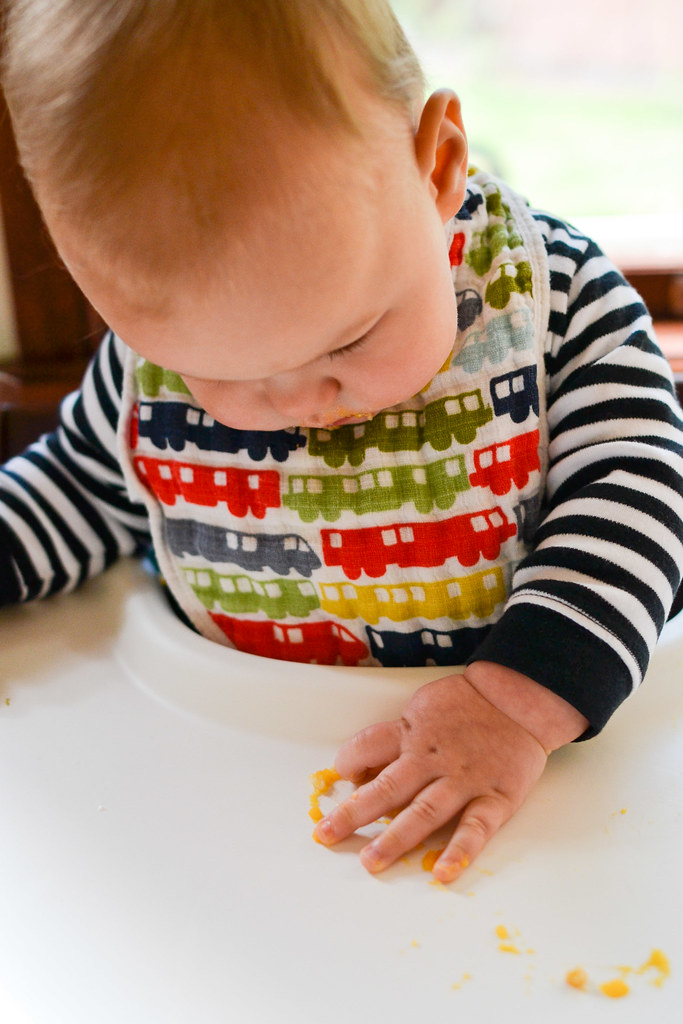
For me, breastfeeding was not a way for me to bond. In fact it was the opposite—it was the only time I really dreaded spending with the boy. Everyday he was breastfed felt like a countdown to when it would all be over. We were lucky enough to have no problems—I had enough milk, he latched properly—nothing went wrong physically. But mentally, I had to set a goal of getting to six months, or I thought I was going to go insane.
We did a couple things to make it easier for me. First, I pumped a lot in the beginning, and Theo took to a bottle without any issue. This meant Jason could feed him his meal before bedtime while I cooked dinner for us, and we maintained a surplus of stored milk. While I absolutely agree and support all the laws and regulations about breastfeeding in public, I realized right from the beginning that it was not something I wanted to do. Having a bottle I could grab and bring with me when we were out made me much more comfortable.
Another thing that helped greatly was getting him on a feeding schedule. I remember when my mother told me to start getting him into a “routine” when he was a two weeks old and I looked at her like she was undeniably crazy. It seemed unfathomable at that moment that his life could be anything other than a react-to-the-immediate-need scenario. But by four weeks, we were starting to get into a rhythm. He started eating “bigger” meals and stretching out times between feedings until eventually it was about every four hours during the day and one wake up in the middle of the night. This felt much more manageable.
Introducing Solid Foods
I got the go ahead from our pediatrician to start solids at four months. The American Academy of Pediatrics recommends that you wait until six months, but there are certain developmental milestones that a baby hits that tells you they are ready sooner (but no earlier than four months). Theo had hit all of them.
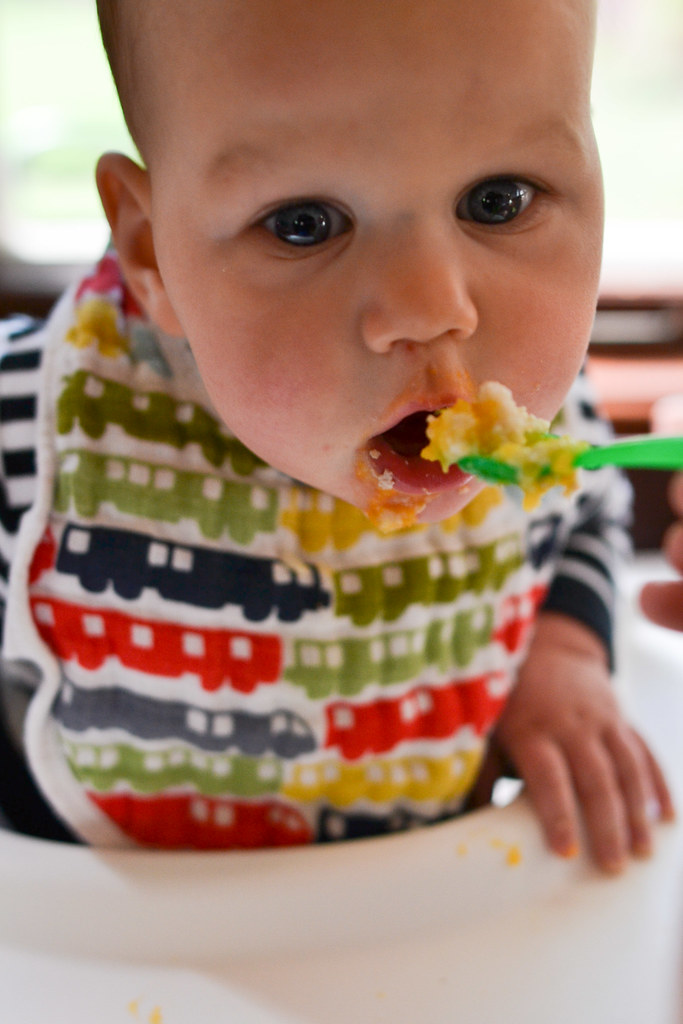
I was so excited! Don’t get me wrong—I was well aware that it would be a long time until he was actually consuming enough solid food to actually meet some nutritional requirements, but the sensory experiment could begun. We started with sweet potatoes—steamed and pureed—and for the first two or three weeks he probably took down a teaspoon at max. Breastfeeding continued as it always did—four feedings a day.
I would offer him solids once a day, but not fret if we skipped a day. He’d play with the food, mash it around, and often times push it out of his mouth and down his chin. It was, as you’d expect, totally adorable and very messy.
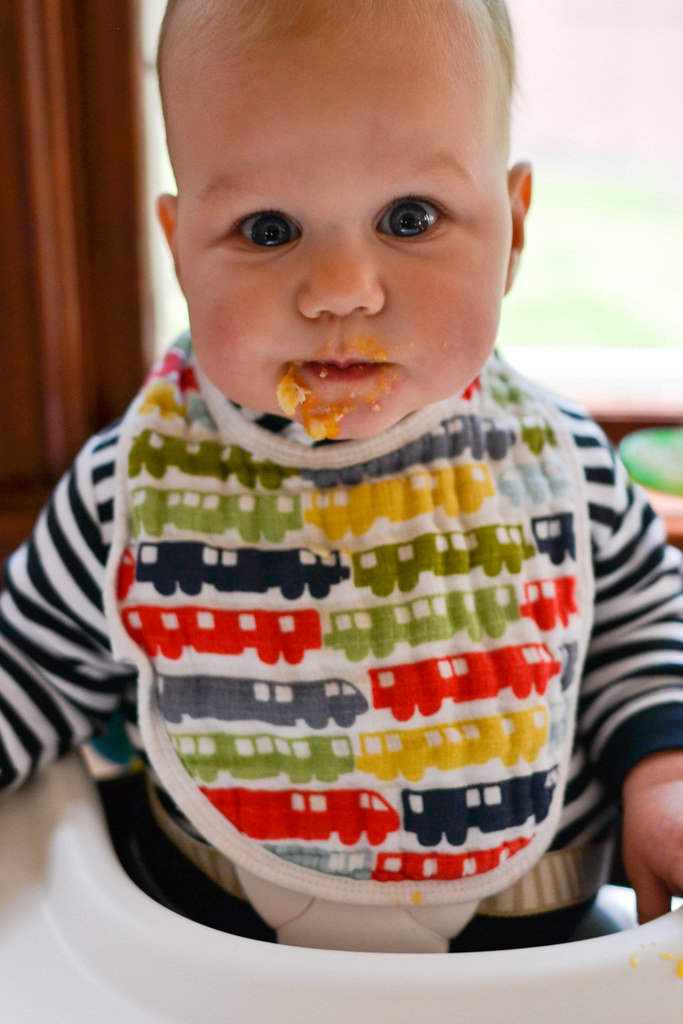
At about five and a half months, everything changed. All of a sudden instead of mashing the food around and swallowing maybe 10% of it, he started launching himself eagerly at the spoon. He seemed to max out at about three to four tablespoons of solids in a sitting, so we’d stop there. In addition to sweet potatoes, he was eating peas, sweet corn, green beans, carrots, and butternut squash. All steamed and pureed, sometimes thinned with a little breast milk if it felt too thick.
The Baby Is Eating Meals!
We started introducing formula into his diet at six months—first mixing together breastmilk and formula and gradually giving him just formula—over the course of three weeks. With the exception of one most likely unrelated projectile vomiting incident, weaning him to formula went really smoothly. And I felt great. I honestly cried tears of happiness when I put the breast pump away the final time. It was over.
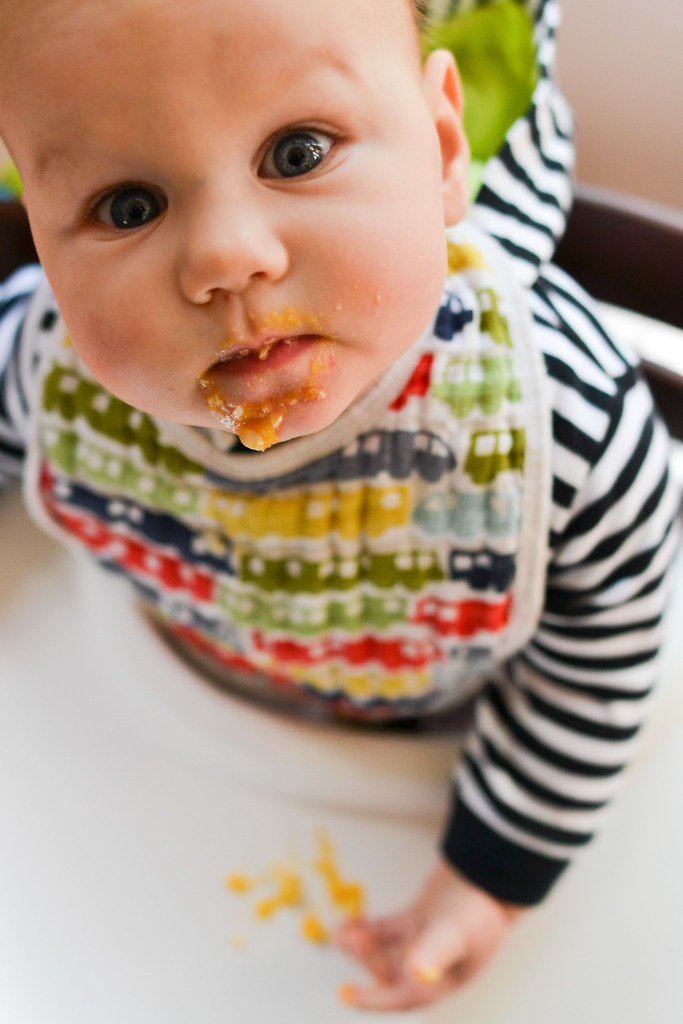
Around the time that he switched to formula we also started referring to “feedings” as meals. Because, after all, Theo is a human being and is finally starting to act like one. At seven months, he started eating three meals a day, plus milk when he wakes up and before he goes to bed.
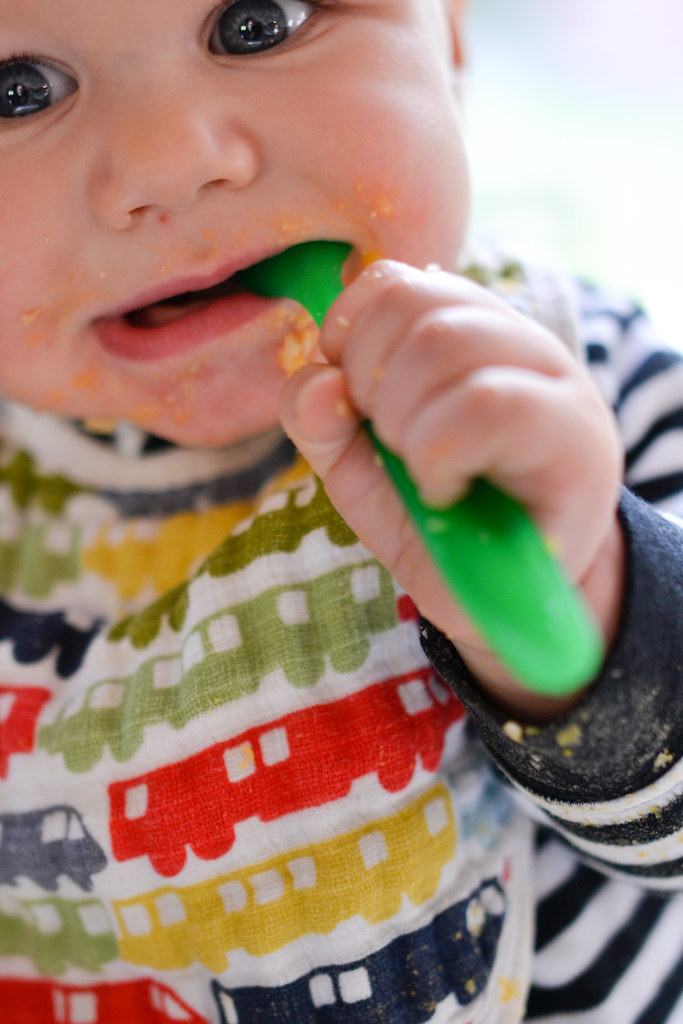
Here’s what a typical day’s menu looks like:
- 6:30AM wake up: 6 ounces of formula
- 8:00AM breakfast: 1/4 cup whole grains, either a hardboiled egg (Monday, Wednesday, Friday) or 2 tablespoons Vitamin A-rich vegetable (remaining days), and 2 tablespoons green vegetable
- 11:30AM lunch: 1/4-1/2 cup dairy, 2 tablespoons vegetables, and 4-6 ounces of formula
- 3:30PM dinner: 1/4 cup whole grains, 1 tablespoon protein, 2 tablespoons vegetables, and 4-6 ounces of formula
- 7:00PM bedtime: 8-10 ounces of formula
As far as what falls into each category, here is a list of foods in the order I introduced them, and how they’re prepared:
- Whole grains: whole brown rice, oats, millet (up next). Cooked based on packaging instructions and then pureed in a food processor.
- Vitamin-A vegetables: sweet potatoes, carrots, butternut squash, pumpkin (up next). Cut into large pieces, steamed, and then pureed in a food processor.
- Green vegetables: peas, green beans, asparagus. Steamed and then pureed in a food processor.
- Other vegetables: sweet corn. Cooked on the cob, cut off, then pureed in a food processor.
- Dairy: full fat cottage cheese, whole milk yogurt.
- Protein: chicken. Poached in water, pureed in a food processor.
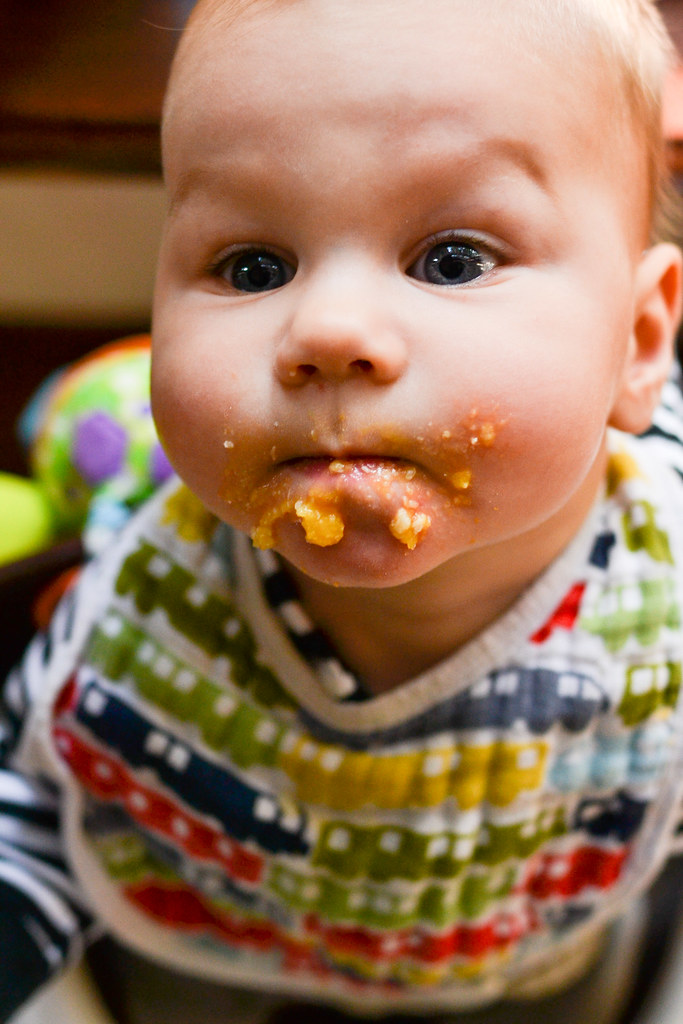
I know if I were to read this a couple months ago, I would be completely overwhelmed by the prospect of doing it all. But, I’ve gotten my cooking process down to a science, and it honestly doesn’t take too much time at all. For the sake of not writing the longest post ever, I’ll save the process for cooking for Theo until next months post. Until then, feel free to ask me any questions. But please save any judgy comments for yourself (pretty please?!?).








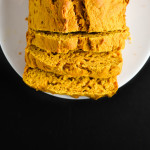

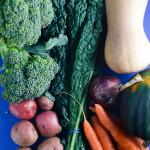




He’s so sweet Vicky! I just love “dirty face” mealtime photos of babies!
writes CarissaLess sweet are the photos of the dirty, dirty floor. Thanks, Carissa!
writes VickyDelurking to say: Don’t ever apologize to anyone about not being OMG so in love with breastfeeding. They can shut it.
writes JoannaJust looked up what delurking means. Learn something new everyday!
writes VickyThe pics are great, Vicky. He has such beautiful eyes!
writes Beth RomanThanks for sharing this Vicky, you give me hope!
writes Sarah Artz[…] but sadly, I was eating alone. Jason’s traveling for work and Theo goes to bed at seven. Baby loves squash though. Maybe next time I’ll wake him up for […]
writes Acorn Squash and Blue Cheese Pasta with Spinach - Things I Made TodayWay to go, Mama!
writes Cindy[…] and even though I know my husband is perfectly capable—in fact more than capable—of feeding the boy, I must make sure things go as planned. Can you tell this is the first time I’m leaving? OMG […]
writes Smoky Beet and Lentil Salad - Things I Made Today[…] month, I wrote my first post about what Theo’s eating and got some very positive […]
writes What Theo's Eating, Month 9 - Things I Made Today1chevrolet
writes 1keyword